인도: GLAQ는 저압 저산소증으로 인한 기억력 결핍을 예방합니다
6월 2, 2020/국방생리연구소& 연합 과학(인도)/과학 보고서
문자/우 팅야오
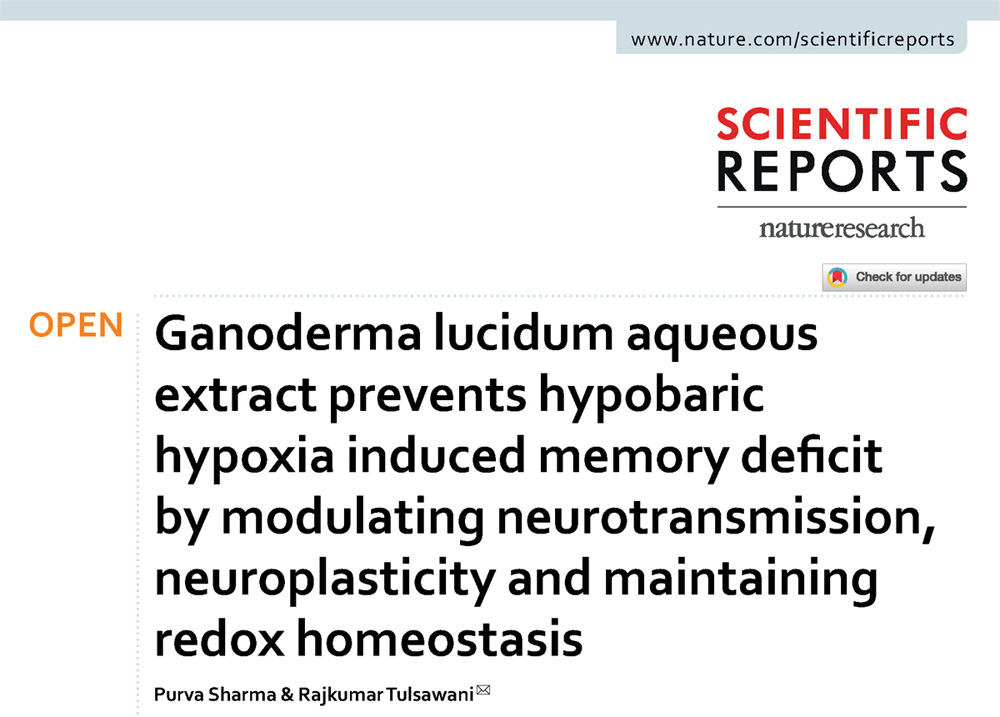
고도가 높을수록, 공기압이 낮을수록, 산소가 더 희석될수록, 생리적 기능의 작동에 더 많은 영향을 미침, 일반적으로 알려진 다양한 건강 위험을 일으킬 가능성이 더 높습니다. 고산병.
이러한 건강 위험은 단지 두통일 수 있습니다., 현기증, 메스꺼움, 구토, 피로 및 기타 불편함, 인지에 영향을 미치는 뇌부종으로 발전할 수도 있습니다., 모터, 그리고 의식 기능, 또는 호흡 기능에 영향을 미치는 폐부종. 상황이 얼마나 심각한지? 휴식을 취하면 점차 회복될 수 있는지, 회복 불가능한 손상으로 더욱 악화되거나 심지어 생명을 위협하게 될지는 외부 산소 농도의 변화에 적응하는 신체 조직 세포의 능력에 달려 있습니다..
고산병의 발생 및 심각도는 사람마다 다릅니다., 그리고 개인의 체력에 가장 큰 영향을 받습니다.. 원칙적으로, 위의 고도 1,500 미터 (중간 고도) 인체에 영향을 미치기 시작합니다; 건강한 성인을 포함하여 성급하게 고도에 도달한 사람 2,500 미터 이상 (높은 고도) 신체가 적응하기 전에 문제가 발생하기 쉽습니다..
높은 곳을 오를 때 치밀한 계획을 세웠는지, 출발 전 예방약을 복용했는지, 신체의 적응력을 향상시키고 고산병 발생을 예방하는데 목적이 있습니다.. 하지만 사실, 또 다른 옵션이 있습니다, 그게 걸리는거야영지버섯.
에서 발표한 연구에 따르면 국방 생리학 및 연합 과학 연구소 (호흡) 6월 2020 과학 보고서에서, 그것은 발견되었다 영지버섯 수성 추출물 (GLAQ) 저압성 저산소증으로 인한 뇌신경 손상을 줄이고 공간 기억과 관련된 인지 기능을 유지할 수 있습니다..
물 미로– 쥐의 기억력을 테스트하는 좋은 방법
실험이 시작되기 전, 연구자들은 물 표면 바로 아래에 잠긴 숨겨진 플랫폼을 찾기 위해 쥐를 훈련시키는 데 며칠을 보냈습니다.. (수치 1).
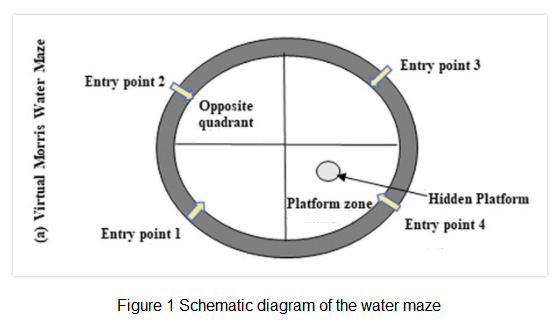
쥐는 수영을 잘해요, 하지만 그 사람들은 물을 좋아하지 않아, 그래서 그들은 물을 피할 수 있는 장소를 찾으려고 노력할 것입니다.
그림의 수영 궤적 기록에 따르면 2, 쥐들은 첫날 여러 번 돌아다니다가 6일째 직선주변까지 점점 더 빠르게 플랫폼을 발견한 것을 확인할 수 있었습니다. (그림의 오른쪽 세 번째 2), 좋은 공간 기억 능력을 가지고 있음을 보여줍니다..
플랫폼을 제거한 후, 플랫폼이 위치한 지역에 집중된 쥐의 수영 경로 (그림의 첫 번째 오른쪽 2), 이는 쥐가 플랫폼이 어디에 있는지 명확한 기억을 가지고 있음을 나타냅니다..
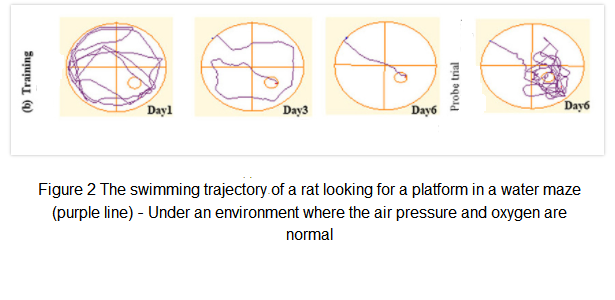
영지버섯 저압성 저산소증이 공간 기억에 미치는 영향을 완화합니다.
훈련된 정상적인 쥐를 두 그룹으로 나누었습니다.. 한 그룹은 대조군으로서 정상적인 기압과 산소가 있는 환경에서 계속 생활했습니다. (제어) 다른 그룹은 저압실로 보내져 초고도에서의 생활을 시뮬레이션했습니다. 25,000 피트 또는 약 7620 저압 저산소증 환경의 미터 (허).
저압실로 보내진 쥐의 경우, 그 중 한 부분에는 다음과 같은 수성 추출물을 공급했습니다.영지버섯 (GLAQ) 매일 복용량으로 100, 200, 또는 400 mg/kg (HH+GLAQ 100, 200, 또는 400) 다른 부분은 먹이를 주지 않았지만영지버섯 (HH그룹) 통제 그룹으로.
이 실험은 일주일 동안 지속되었습니다.. 실험이 끝난 다음 날, 다섯 그룹의 쥐를 물 미로에 넣어 플랫폼의 위치를 기억하는지 확인했습니다.. 결과는 그림에 나와 있습니다. 3:
대조군 (제어) 여전히 플랫폼의 위치를 명확하게 기억하고 있으며 플랫폼을 즉시 찾을 수 있었습니다.; 저압 챔버 쥐의 기억 능력 (허) 크게 손상되었습니다, 플랫폼을 찾는 데 걸리는 시간은 통제 그룹보다 2배 이상 길었습니다.. 하지만 저압실의 저산소 환경에서도 생활하고 있습니다., GLAQ을 먹은 쥐는 플랫폼에 대한 기억력이 훨씬 더 뛰어났습니다., 그리고 더영지버섯 그들은 먹었다, 소요된 시간은 일반 대조군의 시간과 더 가까웠습니다..
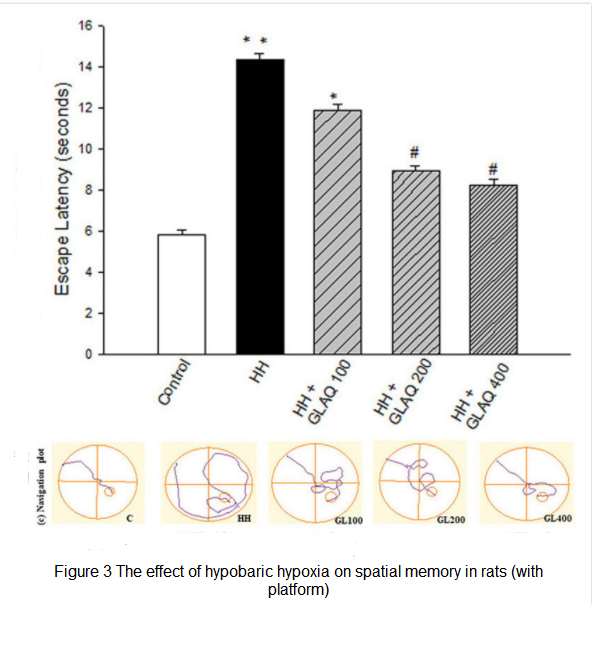
영지버섯 저압성 저산소증이 공간 기억에 미치는 영향을 완화합니다.
훈련된 정상적인 쥐를 두 그룹으로 나누었습니다.. 한 그룹은 대조군으로서 정상적인 기압과 산소가 있는 환경에서 계속 생활했습니다. (제어) 다른 그룹은 저압실로 보내져 초고도에서의 생활을 시뮬레이션했습니다. 25,000 피트 또는 약 7620 저압 저산소증 환경의 미터 (허).
저압실로 보내진 쥐의 경우, 그 중 한 부분에는 다음과 같은 수성 추출물을 공급했습니다.영지버섯 (GLAQ) 매일 복용량으로 100, 200, 또는 400 mg/kg (HH+GLAQ 100, 200, 또는 400) 다른 부분은 먹이를 주지 않았지만영지버섯 (HH그룹) 통제 그룹으로.
이 실험은 일주일 동안 지속되었습니다.. 실험이 끝난 다음 날, 다섯 그룹의 쥐를 물 미로에 넣어 플랫폼의 위치를 기억하는지 확인했습니다.. 결과는 그림에 나와 있습니다. 3:
대조군 (제어) 여전히 플랫폼의 위치를 명확하게 기억하고 있으며 플랫폼을 즉시 찾을 수 있었습니다.; 저압 챔버 쥐의 기억 능력 (허) 크게 손상되었습니다, 플랫폼을 찾는 데 걸리는 시간은 통제 그룹보다 2배 이상 길었습니다.. 하지만 저압실의 저산소 환경에서도 생활하고 있습니다., GLAQ을 먹은 쥐는 플랫폼에 대한 기억력이 훨씬 더 뛰어났습니다., 그리고 더영지버섯 그들은 먹었다, 소요된 시간은 일반 대조군의 시간과 더 가까웠습니다..
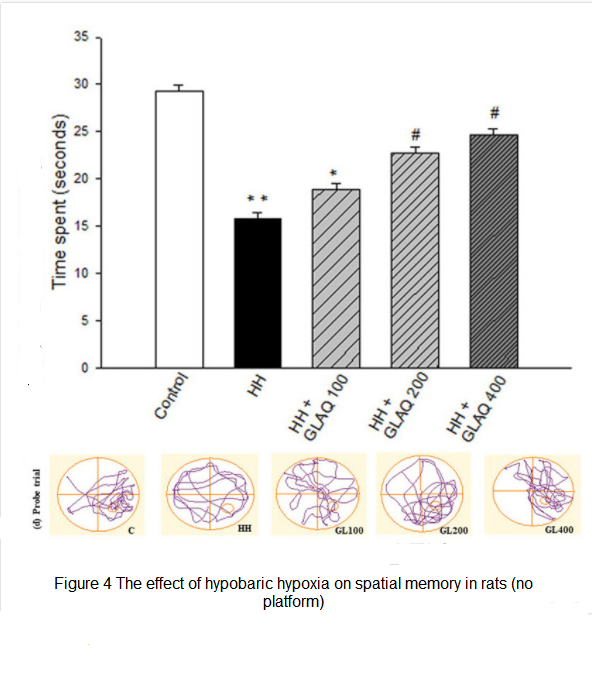
영지버섯 뇌를 보호하고 뇌부종과 해마이랑 손상을 감소시킵니다..
위의 실험 결과는영지버섯 저압성 저산소증으로 인한 공간 기억 장애를 실제로 완화할 수 있습니다.. 기억 기능은 뇌의 구조와 작동이 정상적인지 여부를 나타내는 지표입니다.. 그러므로, 연구진은 실험용 쥐의 뇌 조직을 추가로 해부하고 분석했습니다., 그리고 그걸 발견했어:
저압성 저산소증은 혈관 부종을 일으킬 수 있습니다 (모세혈관의 투과성이 증가하면 많은 양의 체액이 혈관에서 누출되어 뇌의 간질 공간에 축적됩니다.) 그리고 해마이랑 (기억 형성을 담당하는) 손상, 하지만 사전에 GLAQ를 먹인 쥐에서는 이러한 문제가 많이 완화되었습니다. (수치 5 그리고 6), 것을 나타내는영지버섯 뇌를 보호하는 효과가 있다.
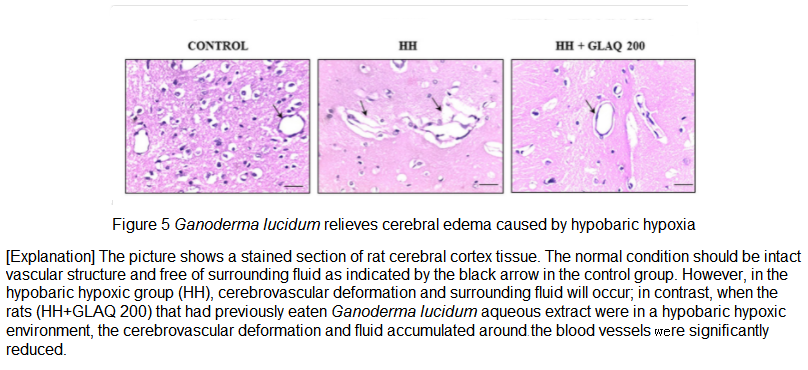
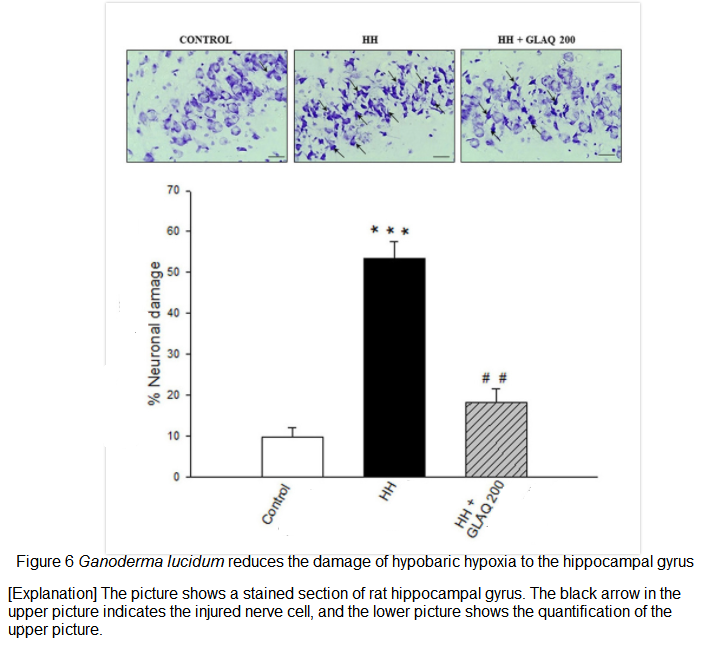
메커니즘영지버섯 저압성 저산소증에 대하여
왜영지버섯 수성 추출물은 저압성 저산소증으로 인한 손상을 견딜 수 있습니다? 더 심도 있는 논의의 결과는 그림에 요약되어 있습니다. 7. 기본적으로 두 가지 일반적인 방향이 있습니다.:
한편으로는, 저압성 저산소증에 적응할 때 신체의 생리적 반응은 다음의 개입으로 인해 더 빠르고 더 잘 조정될 것입니다.영지버섯; 반면에, 영지버섯 항산화 및 항염증을 통해 뇌 신경 세포의 관련 분자를 직접 조절할 수 있습니다., 체내 산소를 일정하게 유지, 뇌의 신경 회로 조정, 신경조직과 기억력을 보호하기 위해 원활한 신경 전달을 유지합니다..
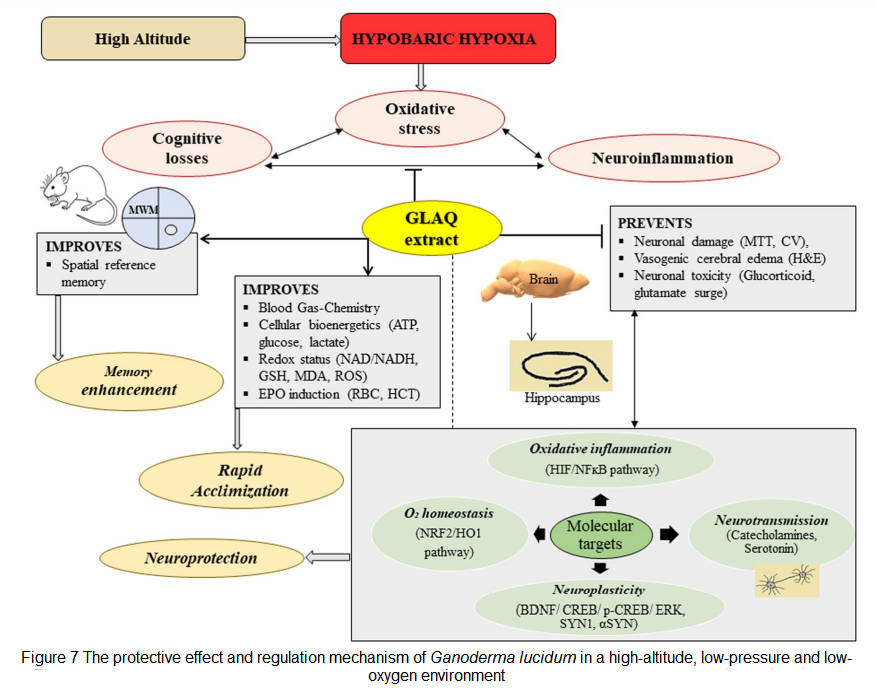
과거에, 많은 연구에서 다음과 같이 지적했습니다.영지버섯 알츠하이머병 등 다양한 측면에서 뇌신경을 보호할 수 있습니다., 파킨슨병, 간질, 혈관색전증, 우발적인 뇌 손상, 그리고 노화. 이제 인도의 이 연구는 다음과 같은 또 다른 증거를 추가합니다.영지버섯높은 고도의 관점에서 본 '지혜와 기억력 향상', 저기압과 낮은 산소.
특히, 연구 단위 국방 생리학 연구소& 연합 과학 (호흡) 국방연구개발기구 소속 (DRDO) 인도 국방부의. 오랫동안 고산생리학 분야를 심층적으로 탐구해 왔습니다.. 고지대 환경과 압력에 대한 군인의 적응성과 전투 효율성을 향상시키는 방법은 항상 관심의 초점이었습니다.. 이는 이번 연구 결과를 더욱 의미 있게 만든다..
에 함유된 활성성분은영지버섯 본 연구에 사용된 수성 추출물 GLAQ에는 다당류가 포함됩니다., 페놀, 플라보노이드, 및 가노데르산 A. 이 연구를 발표하기 전에, 연구진은 해당 추출물에 대해 90일간 아만성독성시험을 실시한 결과, 그 복용량이 1000 mg/kg, 조직에 부정적인 영향을 미치지 않습니다., 쥐의 장기와 성장. 그러므로, 최소 유효 복용량 200 위 실험에서 mg/kg은 확실히 안전합니다..
준비가 완벽해야 등반의 즐거움을 누릴 수 있고, 스카이라인과 가까워지는 촉감을 경험할 수 있습니다.. 금고가 있다면영지버섯 당신을 응원하기 위해, 당신의 소망을 더욱 안전하게 실현할 수 있을 것입니다.
[원천]
1. 푸르바 샤르마, 라지쿠마르 툴사와니. 영지버섯 수성 추출물은 신경 전달을 조절하여 저압 저산소증으로 인한 기억력 결핍을 예방합니다., 신경가소성과 산화환원 항상성 유지. 과학 담당자. 2020; 10: 8944. 온라인에 게시됨 2020 준 2.
2. 푸르바 샤르마, 외. 약리학적 효과 영지버섯 고도 스트레스 요인에 대한 추출물 및 아만성 독성 평가. 제이푸드바이오켐. 2019 12월;43(12):e13081.
끝
저자 소개 / 씨. 우팅야오
Wu Tingyao는 이후 직접 Ganoderma 정보를 보고해 왔습니다. 1999. 그녀는 다음의 저자입니다.Ganoderma로 치유 (4월 인민의학출판사에 게재 2017).
★ 이 글은 저자의 단독 승인 하에 게재되었습니다..
★ 위 작품은 복제할 수 없습니다, 저작자의 허락 없이 발췌하거나 다른 방법으로 사용한 경우.
★ 위 사항을 위반한 경우, 저자는 관련 법적 책임을 추구할 것입니다.
★ 이 기사의 원문은 Wu Tingyao가 중국어로 작성하고 Alfred Liu가 영어로 번역했습니다.. 번역 내용에 차이가 있는 경우 (영어) 그리고 원본 (중국인), 원래 중국어가 우선합니다. 독자들이 궁금한 점이 있으면, 원작자에게 연락주세요, 양. 우팅야오.



